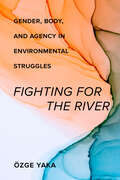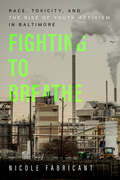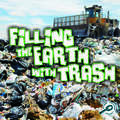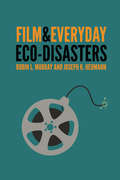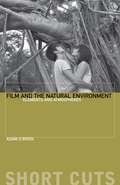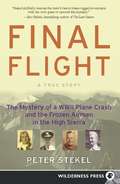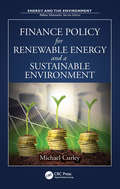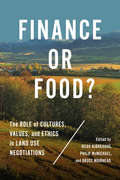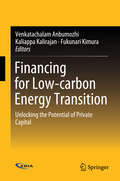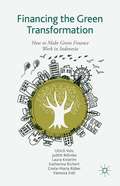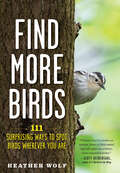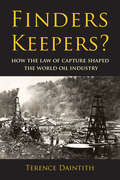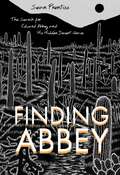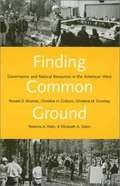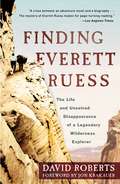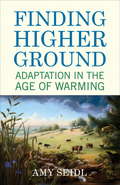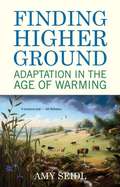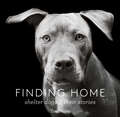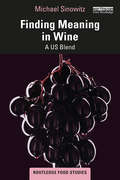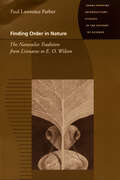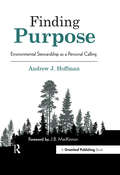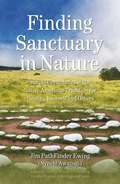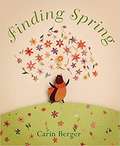- Table View
- List View
Fighting for the River: Gender, Body, and Agency in Environmental Struggles
by Özge YakaFighting for the River portrays women's intimate, embodied relationships with river waters and explores how those relationships embolden local communities' resistance to private run-of-the-river hydroelectric power plants in Turkey. Building on extensive ethnographic research, Özge Yaka develops a body-centered, phenomenological approach to women's environmental activism and combines it with a relational ontological perspective. In this way, the book pushes beyond the "natural resources" frame to demonstrate how our corporeal connection to nonhuman entities is constitutive of our more-than-human lifeworld. Fighting for the River takes the human body as a starting point to explore the connection between lived experience and nonhuman environments, treating bodily senses and affects as the media of more-than-human connectivity and political agency. Analyzing local environmental struggles as struggles for coexistence, Yaka frames human-nonhuman relationality as a matter of socio-ecological justice.
Fighting to Breathe: Race, Toxicity, and the Rise of Youth Activism in Baltimore (California Series in Public Anthropology #54)
by Nicole FabricantIndustrial toxic emissions on the South Baltimore Peninsula are among the highest in the nation. Because of the concentration of factories and other chemical industries in their neighborhoods, residents face elevated rates of lung cancer and other respiratory illnesses in addition to heart attacks, strokes, and cardiovascular disease, all of which can lead to premature death. Fighting to Breathe follows a dynamic and creative group of high school students who decided to fight back against the race- and class-based health disparities and inequality in their city. For more than a decade, student organizers stood up to unequal land use practices and the proposed construction of an incinerator and instead initiated new waste management strategies. As a Baltimore resident and activist-scholar, Nicole Fabricant documents how these young organizers came to envision, design, and create a more just and sustainable Baltimore.
Filling The Earth With Trash (Green Earth Science Discovery Library)
by Jeanne SturmYoung Readers Will Discover What Happens To Trash In A Landfill.
Film and Everyday Eco-disasters
by Robin L. Murray Joseph K. HeumannEco-disasters such as coal-mining accidents, oil spills, and food-borne diseases appear regularly in the news, making them seem nearly commonplace. These ecological crises highlight the continual tensions between human needs and the environmental impact these needs produce. Contemporary documentaries and feature films explore environmental-human conflicts by depicting the consequences of our overconsumption and dependence on nonrenewable energy.Film and Everyday Eco-disasters examines changing perspectives toward everyday eco-disasters as reflected in the work of filmmakers from the silent era forward, with an emphasis on recent films such as Dead Ahead, an HBO dramatization of the Exxon Valdez disaster; Total Recall, a science fiction action film highlighting oxygen as a commodity; The Devil Wears Prada, a comment on the fashion industry; and Food, Inc., a documentary interrogation of the food industry. The authors evaluate not only the success of these films as rhetorical arguments but also their rhetorical strategies. This interdisciplinary approach to film studies fuses cultural, economic, and literary critiques in articulating an approach to ecology that points to sustainable development as an alternative to resource exploitations and their associated everyday eco-disasters.
Film and the Natural Environment: Elements and Atmospheres (Short Cuts)
by Adam O'BrienEnvironmental themes are present in cinema more than ever before. But the relationship between film and the natural world is a long and complex one, not reducible to issues such as climate change and pollution. This volume demonstrates how an awareness of natural features and dynamics can enhance our understanding of three key film-studies topics – narrative, genre, and national cinema. It does so by drawing on examples from a broad historical and geographical spectrum, including Sunrise, A River Called Titas, and Profound Desires of the Gods. The first introductory text on a topic which has long been overlooked in the discipline, Film and the Natural Environment argues that the nonhuman world can be understood not just as a theme but as a creative resource available to all filmmakers. It invites readers to consider some of the particular strengths and weaknesses of cinema as communicator of environmental phenomena, and collates ideas and passages from a range of critics and theorists who have contributed to our understanding of moving images and the natural world.
Final Flight
by Peter StekelIn October 2005, two mountaineers climbing above Mendel Glacier in the High Sierra finds the mummified remains of a man in a WW II uniform, entombed in the ice. The "Iceman" discovery creates a media storm which draws author Peter Stekel to investigate and stumble upon the case of a navigation training flight crew missing since 1942. Early attempts at recovery are thwarted due to empty graves, botched records, bad weather, bad luck, and bad timing. Then, in 2007, Stekel himself discovers a second body in the glacier. Through meticulous research, interviews, and his own mountaineering trips to the site, Stekel uncovers the identities of these four young men. Final Flight explores the story of the ill-fated flight and the misinformation surrounding it for over 60 years. The book is a gripping account that's part mystery, part history, and a personal journey to uncover the truth of the events that occurred on November 18, 1942. In the process, Stekel rewrites the young aviators' last days and takes us on their final flight.
Finance Policy for Renewable Energy and a Sustainable Environment (ISSN)
by Michael CurleyThis book explains how environmental projects and improvements are achieved through the imposition of regulations, on the one hand, and financial incentives on the other. It discusses how those incentives can be organized to achieve the greatest environmental benefits at the lowest possible cost to the public. It presents the best environmental finance policies for the financing of alternative energy projects so that the ultimate cost of delivered power will decline. It also examines the challenges of the next generation of environmental programs.
Finance or Food?: The Role of Cultures, Values, and Ethics in Land Use Negotiations
by Philip McMichael Hilde Bjørkhaug Bruce MuirheadExploring the ways in which culture, systems of value, and ethics impact agriculture, this volume addresses contemporary land questions and conditions for agricultural land management. Throughout, the editors and contributors consider a range of issues, including pressure on farmland, international and global trade relations, moral and ethical questions, and implications for governance. The focus of Finance or Food? is land use in Australia, Canada, and Norway, chosen for their commonalities as well as their differences. With reference to these specific national contexts, the contributors explore political, ecological, and ethical debates concerning food production, alternative energy, and sustainability. The volume argues that recognition of food, finance, energy, and climate crises is driving investments and reframing the strategies of development agencies. At the same time, food producers, small farmers, and pastoralists facing eviction from their land are making their presence felt in this debate, not just locally, but in national policy arenas and international fora as well. This volume investigates the many ways in which this process is occurring and draws out the cultural implications of new developments in global land use. An important intervention into a timely debate, Finance or Food? will be essential reading for both academics and policymakers.
Financing for Low-carbon Energy Transition: Unlocking the Potential of Private Capital
by Venkatachalam Anbumozhi Kaliappa Kalirajan Fukunari KimuraThis book is the first comprehensive assessment of the state of low-carbon investments in Asia, analyzing the rationales, mandates and public–private financing activities. Based on the experiences of several regional initiatives wherein public financing is catalyzing private investments in low-carbon infrastructure, this book proposes a framework that can be used as a tool to identify factors that influence private investment decisions and policy instruments that can scale up the private capital.Placing the Asian economies onto a low-carbon development pathway requires an unprecedented shift in investments. This book addresses this situation by asking questions such as: • What is the central role of private finance in achieving the Paris Agreement targets? • What key policy levers and risk mitigation can governments use in an effort to unlock the potentials of private capital? • How can regionally coordinated actions hold significant promise for scaling up private investments?
Financing the Green Transformation
by Ulrich Volz Judith Böhnke Vanessa Eidt Laura Knierim Katharina Richert Greta-Maria RoeberPlanetary boundaries and a scarcity of natural resources will require a significant boost of investment into clean and renewable energy and a more efficient use of resources in developing, emerging and advanced economies alike. In this context, the financial sector will have to play a key role in providing 'green finance' for sustainable investment and development. Against this backdrop, this book investigates the challenges for developing and emerging economies in enhancing green financingfor sustainable, low-carbon investment, using Indonesia as a case study. Based on surveys in the Indonesian banking and corporate sectors and expert interviews, the book devises innovative policy recommendations for governments to develop a framework conducive to fostering green investments.
Find More Birds: 111 Surprising Ways To Spot Birds Wherever You Are
by Heather Wolf“Packed with excellent photos and tips, deeply relatable anecdotes, and a palpable sense of joy, this gem of a book will make you a better birder.”—Rosemary Mosco, author of A Pocket Guide to Pigeon Watching A gorgeously photographed trove of 111 ingenious tips for seeing more birds wherever you are—from crowd favorites (hummingbirds, owls, eagles) to species you’ve never spotted before Seeing more birds than you ever imagined and witnessing exciting avian drama is possible—whether you’re on the go or in your own neighborhood, local park, or backyard. As Heather Wolf explains, it all comes down to how you tune in to the show happening around you, the one in which birds—highly skilled at staying under the radar—are the stars. In Find More Birds, Heather shares her very best tactics—and the jaw-dropping photographs they helped her capture. Look for birds at their favorite “restaurants”— from leaf litter to berry bushes, and ball fields to small patches of mud. Watch for “tree bark” that moves . . . you may find it has feathers. Try simply sitting on the ground for a revealing new perspective. Plus, special tips point the way to crowd favorites such as hummingbirds, owls, and eagles—and can’t-miss bird behaviors. As your senses sharpen and “noticing” becomes second nature, Find More Birds will turn your daily routines into bird-finding adventures, too. Whether you’re strolling down the block or parking your car, you never know what will surprise you next!
Finders Keepers?: How the Law of Capture Shaped the World Oil Industry
by Terence DaintithSince the beginnings of the oil industry, production activity has been governed by the 'law of capture,' dictating that one owns the oil recovered from one's property even if it has migrated from under neighboring land. This 'finders keepers' principle has been excoriated by foreign critics as a 'law of the jungle' and identified by American commentators as the root cause of the enormous waste of oil and gas resulting from US production methods in the first half of the twentieth century. Yet while in almost every other country the law of capture is today of marginal significance, it continues in full vigour in the United States, with potentially wasteful results. In this richly documented account, Terence Daintith adopts a historical and comparative perspective to show how legal rules, technical knowledge (or the lack of it) and political ideas combined to shape attitudes and behavior in the business of oil production, leading to the original adoption of the law of capture, its consolidation in the United States, and its marginalization elsewhere.
Finding Abbey: The Search for Edward Abbey and His Hidden Desert Grave
by Sean PrentissWhen the great environmental writer Edward Abbey died in 1989, four of his friends buried him secretly in a hidden desert spot that no one would ever find. The final resting place of the Thoreau of the American West remains unknown and has become part of American folklore. In this book a young writer who went looking for Abbey&’s grave combines an account of his quest with a creative biography of Abbey.Sean Prentiss takes readers across the country as he gathers clues from his research, travel, and interviews with some of Abbey&’s closest friends—including Jack Loeffler, Ken &“Seldom Seen&” Sleight, David Petersen, and Doug Peacock. Along the way, Prentiss examines his own sense of rootlessness as he attempts to unravel Abbey&’s complicated legacy, raising larger questions about the meaning of place and home.
Finding Common Ground: Governance and Natural Resources in the American West
by Ronald D. Brunner Christine H. Colburn Christina M. Cromley Roberta A. KleinOver the past century, solutions to natural resources policy issues have become increasingly complex. Multiple government agencies with overlapping jurisdictions and differing mandates as well as multiple interest groups have contributed to gridlock, frequently preventing solutions in the common interest. Community-based responses to natural resource problems in the American West have demonstrated the potential of local initiatives both for finding common ground on divisive issues and for advancing the common interest. The first chapter of this enlightening book diagnoses contemporary problems of governance in natural resources policy and in the United States generally, then introduces community-based initiatives as responses to those problems. The next chapters examine the range of successes and failures of initiatives in water management in the Upper Clark Fork River in Montana; wolf recovery in the northern Rockies; bison management in greater Yellowstone; and forest policy in northern California. The concluding chapter considers how to harvest experience from these and other cases, offering practical suggestions for diverse participants in community-based initiatives and their supporters, agencies and interest groups, and researchers and educators.
Finding Everett Ruess: The Life and Unsolved Disappearance of a Legendary Wilderness Explorer
by David Roberts Jon KrakauerFinding Everett Ruess by David Roberts, with a foreword by Jon Krakauer, is the definitive biography of the artist, writer, and eloquent celebrator of the wilderness whose bold solo explorations of the American West and mysterious disappearance in the Utah desert at age 20 have earned him a large and devoted cult following. More than 75 years after his vanishing, Ruess stirs the kinds of passion and speculation accorded such legendary doomed American adventurers as Into the Wild's Chris McCandless and Amelia Earhart. "I have not tired of the wilderness; rather I enjoy its beauty and the vagrant life I lead, more keenly all the time. I prefer the saddle to the street car and the star sprinkled sky to a roof, the obscure and difficult trail, leading into the unknown, to any paved highway, and the deep peace of the wild to the discontent bred by cities." So Everett Ruess wrote in his last letter to his brother. And earlier, in a valedictory poem, "Say that I starved; that I was lost and weary; That I was burned and blinded by the desert sun; Footsore, thirsty, sick with strange diseases; Lonely and wet and cold . . . but that I kept my dream!" Wandering alone with burros and pack horses through California and the Southwest for five years in the early 1930s, on voyages lasting as long as ten months, Ruess also became friends with photographers Edward Weston and Dorothea Lange, swapped prints with Ansel Adams, took part in a Hopi ceremony, learned to speak Navajo, and was among the first "outsiders" to venture deeply into what was then (and to some extent still is) largely a little-known wilderness. When he vanished without a trace in November 1934, Ruess left behind thousands of pages of journals, letters, and poems, as well as more than a hundred watercolor paintings and blockprint engravings. A Ruess mystique, initiated by his parents but soon enlarged by readers and critics who, struck by his remarkable connection to the wild, likened him to a fledgling John Muir. Today, the Ruess cult has more adherents--and more passionate ones--than at any time in the seven-plus decades since his disappearance. By now, Everett Ruess is hailed as a paragon of solo exploration, while the mystery of his death remains one of the greatest riddles in the annals of American adventure. David Roberts began probing the life and death of Everett Ruess for National Geographic Adventure magazine in 1998. Finding Everett Ruess is the result of his personal journeys into the remote areas explored by Ruess, his interviews with oldtimers who encountered the young vagabond and with Ruess's closest living relatives, and his deep immersion in Ruess's writings and artwork. It is an epic narrative of a driven and acutely perceptive young adventurer's expeditions into the wildernesses of landscape and self-discovery, as well as an absorbing investigation of the continuing mystery of his disappearance. In this definitive account of Ruess's extraordinary life and the enigma of his vanishing, David Roberts eloquently captures Ruess's tragic genius and ongoing fascination.From the Hardcover edition.
Finding Higher Ground
by Amy SeidlWhile much of the global warming conversation rightly focuses on reducing our carbon footprint, the reality is that even if we were to immediately cease emissions, we would still face climate change into the next millennium. In Finding Higher Ground, Amy Seidl takes the uniquely positive--yet realistic--position that humans and animals can adapt and persist despite these changes. Drawing on an emerging body of scientific research, Seidl brings us stories of adaptation from the natural world and from human communities. She offers examples of how plants, insects, birds, and mammals are already adapting both behaviorally and genetically. While some species will be unable to adapt to new conditions quickly enough to survive, Seidl argues that those that do can show us how to increase our own capacity for resilience if we work to change our collective behavior. In looking at climate change as an opportunity to establish new cultural norms, Seidl inspires readers to move beyond loss and offers a refreshing call to evolve.From the Hardcover edition.
Finding Higher Ground: Adaptation in the Age of Warming
by Amy SeidlAn ecologist takes the uniquely positive--yet realistic--position that we can adapt and persist despite the inevitable effects of climate change. While much of the global warming conversation rightly focuses on reducing our carbon footprint, the reality is that even if we were to immediately cease emissions, we would still face climate change into the next millennium. In Finding Higher Ground, Amy Seidl takes the uniquely positive--yet realistic--position that humans and animals can adapt and persist despite these changes. Drawing on an emerging body of scientific research, Seidl brings us stories of adaptation from the natural world and from human communities. She offers examples of how plants, insects, birds, and mammals are already adapting both behaviorally and genetically. Within ten years, one plant species in a drought-stricken area has evolved to fit its life cycle into the shorter growing season. Red squirrels are breeding earlier to take advantage of the food supplied by an earlier spring. And some birds are migrating shorter distances, or not at all, as their northern habitats become milder. While some species will be unable to adapt to new conditions quickly enough to survive, Seidl argues that those that do can show us how to increase our own capacity for resilience. She tells of a young farmer experimenting with adaptive strategies for local crops, architects using biomimicry to design buildings that actually contribute to their surrounding ecosystems, and the establishment of decentralized and renewable energy banks. While Seidl admits that these efforts alone won't change the world, she hopes that taken together they can form the basis for a new, revolutionary set of ideas to live by, much like the efforts that brought about abolition, women's suffrage, and the eight-hour workday. In looking at climate change as an opportunity to establish new cultural norms, Seidl's perspective inspires readers to move beyond loss and offers a refreshing call to evolve.
Finding Home: Shelter Dogs & Their Stories
by Traer ScottHeart-touching photographs and rescue stories: &“Do yourself a favor. Read Finding Home, then go out and adopt a shelter dog.&” —Chicago Tribune Bold, retiring, serious, sparkling, or quirky—the dogs in Traer Scott&’s remarkable photographs regard us with humor, dignity, and an abundance of feeling. Scott began photographing these dogs in 2005 as a volunteer at animal shelters. Following the runaway success of her first book, Shelter Dogs, she now introduces a new collection of canine subjects, each with indomitable character and spirit: Morrissey, a pit bull, who suffered from anxiety-related behaviors brought on by shelter life until adopted by a family with four children Chloe, a young chocolate Lab mix, surrendered to a shelter by a family with allergies Gabriel and Cody, retired racing greyhounds Bingley, a dog who lost his hearing during a drug bust but was brought home by a loving family that has risen to the challenge of living with a deaf dog Through text and photos, we become better acquainted with the personalities and life stories of selected dogs and watch as they experience the sometimes rocky and always emotional transition to new homes. The portraits in Finding Home form an eloquent plea for more of the urgently needed adoptive families, as well as a tribute to dogs everywhere.
Finding Meaning in Wine: A US Blend (Routledge Food Studies)
by Michael SinowitzThis book examines controversies in American wine culture and how those controversies intersect with and illuminate current academic and cultural debates about the environment and about interpretation. With a specific focus on the United States of America, the methods that we use to discuss literature and other art are applied to wine-making and wine culture. The book explores the debates about how to evaluate wine and the problems inherent in numerical scoring as well as evaluative tasting notes, whether winemakers can be artists, the discourse in wine culture involving natural wine and biodynamic farming, as well as how people judge what makes a wine great. These interpretative commitments illuminate an underlying metaphysics and allegiance to a culture of reason or feeling. The discussions engage with a broad range of writers and thinkers, such as Roland Barthes, Susan Sontag, Louis Menand, Michael Pollan, Greg Garrard, John Guillory, Amitov Ghosh, Pierre Bourdieu, and Barbara Herrnstein-Smith. The book draws upon not only a number of texts produced by wine critics, wine writers, literary critics and theorists but also extensive interviews with wine writers and multiple California winemakers. These interviews contribute to a unique reflection on wine and meaning. This book will be of great interest to readers looking to learn more about wine from cultural, literary, and philosophical perspectives.
Finding Order In Nature: The Naturalist Tradition from Linnaeus to E. O. Wilson (Johns Hopkins Introductory Studies in th)
by Paul Lawrence Farber“Engaging . . . a concise work that gives the general reader a solid understanding . . . an excellent introduction to the history of natural history.” —Library JournalSince emerging as a discipline in the middle of the eighteenth century, natural history has been at the heart of the life sciences. It gave rise to the major organizing theory of life—evolution—and continues to be a vital science with impressive practical value. Central to advanced work in ecology, agriculture, medicine, and environmental science, natural history also attracts enormous popular interest.In Finding Order in Nature Paul Farber traces the development of the naturalist tradition since the Enlightenment and considers its relationship to other research areas in the life sciences. Written for the general reader and student alike, the volume explores the adventures of early naturalists, the ideas that lay behind classification systems, the development of museums and zoos, and the range of motives that led collectors to collect. Farber also explores the importance of sociocultural contexts, institutional settings, and government funding in the story of this durable discipline.“The history of natural history can rarely have been as succinctly told as in Paul Lawrence Farber’s 129-page Finding Order in Nature. From the intellectual revolutions of Linnaeus and Darwin through the Victorian obsessions with classifying and collecting, to the conservationists led by E. O. Wilson, it is an odyssey beautifully told.” —New Scientist“Farber does an impressive job of demonstrating how practitioners like Linnaeus, Buffon, Saint-Hilaire and Cuvier advanced the field and set the stage for the development of science as we know it today.” —Publishers Weekly
Finding Purpose: Environmental Stewardship as a Personal Calling
by Andrew J. HoffmanBoth thoughtful and thought-provoking, Finding Purpose aims to challenge our understanding of how humanity interacts with planet Earth, and our role within this. This book is an invitation: would you like to participate in one of the most important projects of imagination, perhaps the greatest ever, in human history? Distilling and refining over 20 pieces from a lifetime of work in academia and trade, across speeches, blogs, editorials and essays, Hoffman invites us to look beyond material growth and explore the role of the individual and business in discovering a wider purpose to bring about a balanced and sustainable society. The reader is encouraged to consider humanity’s relationship with the environment through different lenses: business, academia, faith-based and cultural. By bringing them together, Hoffman encourages us to understand our relationship with the planet in a far more holistic sense. Drawing on ideas from philosophy, literature, natural sciences and politics, Hoffman ensures that the ideas he explores are wholly accessible and applicable. Fully substantiated through various research and examples, the issues described are consistently made relevant to the reader.Finding Purpose is the perfect book for anyone – from student to CEO – thinking about their place in the world, and how making changes in our own lives and societies can impact on the world around us.
Finding Sanctuary in Nature
by Jim Pathfinder EwingThese spiritual lessons are based on Native American shamanism but fit a wide range of interests from yoga and alternative medicine to Bible study and nature hiking. Hands-on exercises, step-by-step instructions for ceremonies, and sketches by the author's wife explain how to clear spaces of unwanted energy, create simple ceremonies, connect with spirit guides and angels, and interpret symbols. An extended discussion tells how to make a medicine wheel that resembles a labyrinth and use it as an engine for distance healing. Additional ceremonies for daily living, healing the earth, and soul retrieval are also described, and the spiritual quest itself is shown to follow the process of choosing a sacred place in nature, finding a sacred place within oneself, and connecting to the inner and outer worlds. Readers are encouraged to keep a notebook about their spiritual growth and refer to the key words and suggestions for internet research that are included.
Finding Someplace
by Denise Lewis PatrickReesie Boone just knows that thirteen is going to be her best year yet-this will be the year she makes her very first fashion design on her Ma Maw's sewing machine. She'll skip down the streets of New Orleans with her best friends, Ayanna and Orlando, and everyone will look at her in admiration.But on Reesie's birthday, everything changes. Hurricane Katrina hits her city. Stranded at home alone, Reesie takes refuge with her elderly neighbor, Miss Martine. The waters rise. They escape in a boat. And soon Reesie is reunited with her family. But her journey back home has only begun.This is a story of a family putting itself back together, and a young girl learning to find herself.A Christy Ottaviano Book
Finding Spring
by Carin BergerInstead of hibernating as he should, a little bear cub goes out in search of spring—and he thinks he's found it! Gloriously illustrated with dioramas and cut-paper collages by the award-winning designer and illustrator Carin Berger, this stunning picture book celebrates the changing of the seasons.
Finding Wild
by Megan Wagner LloydA lovely, lyrical picture book with gorgeous illustrations that explores the ways the wild makes itself known to us and how much closer it is than we think. There are so many places that wild can exist, if only you know where to look! Can you find it? Two kids set off on an adventure away from their urban home and discover all the beauty of the natural world. From the bark on the trees to the sudden storm that moves across the sky to fire and flowers, and snowflakes and fresh fruit. As the children make their way through the woods and back to the paved and noisy streets, they discover that wild exists not just off in some distant place, but right in their own backyard.*"Sometimes the most striking picture books are the ones that make readers see something in a new way, or that creatively express a concept regularly pondered but rarely put into words."--Shelf Awareness, starred review"Lloyd&’s sparkling debut celebrates nature through a whimsical meditation on the idea of wildness. Halpin&’s lush and delicately detailed mixed-media pictures...dominated by muted greens and blues pull readers into the diverse landscapes the children traverse. A spirit of adventure and exploration runs throughout the book." --Publishers Weekly
